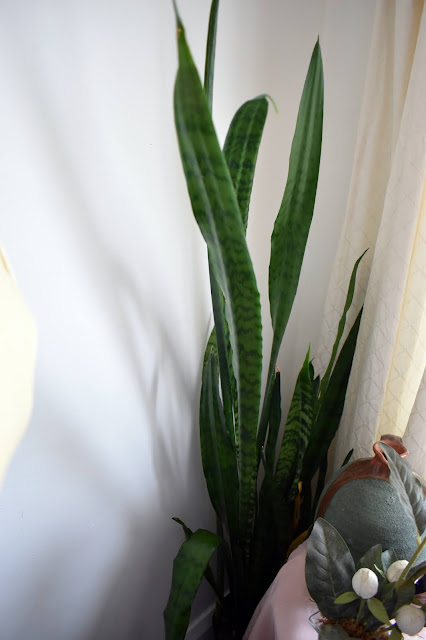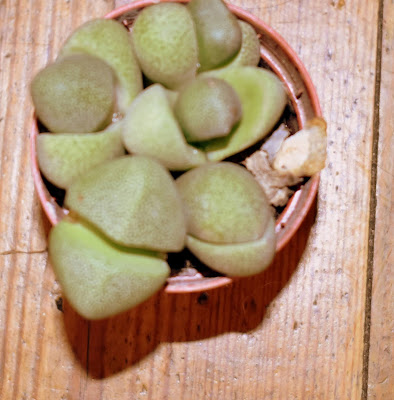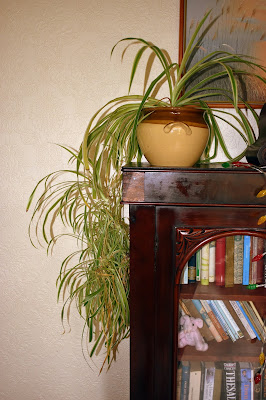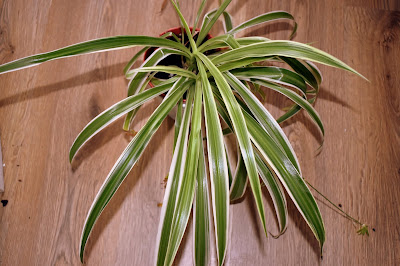A Houseplant With Many Common Names
This striking plant has a prolific number of strange common names which include Mother In Laws Tongue- supposedly the ends of the leaves looking like the sharp tongue of the mother in law. Now I loved my Mum in law to bits so this does not hold true, but that is folklore...
Its other commons names are Snake plant as it could look a little like a snake and St Georges Sword due to its sword like look.
In addition it is known as Viper's Bowstring Hemp due to it being one of the sources for plant fibers used to make bowstrings.
It is also known as the good luck plant! There may well be many more names but that is enough names for one plant!
Its Scientific name is Sansevieria trifasciata. In our home it was always known as Mother In laws Tongue. In this article I will refer to it as the Mother In Laws Tongue or the Snake Plant.
It is a rather bold, striking houseplant with smooth thick sword like leaves hence I can see the St Georges Sword common name.
The leaves are not soft but neither are they spiky rather firm and bold to the touch. They have I think rather beautiful individual markings which are worth apprecaiting close up and I can totally see why they are given the common name of Snake Plant.

|
| Markings that give "Snake Plant" its common name. |
I can tend to these plants without gloves though I would wear gloves to repot. It can grow up to 3 or 4 feet high.
It does flower but the flowers are insignificant and few people would grow it for its flowers. Neither is it scented. You need to like the shape and colour of the leaves to have this plant in your home.
We always had two or three of these indoor plants around our home and the ones I have now are decendants or the original from my parents home. I find these house plants to be long lived and trouble free.
It is essentially a succulent and as such needs a few care pointers which I cover below but is essentially a very easy houseplant to look after.
Watering And Feeding The Mother In Laws Tongue.
This plant has adapted to thrive on little water. All I do is to give it a good watering when I remember and let the soil dry out in between waterings. We need to water the soil, never the leaves or the space between the leaves as this will not be good for the plant.
If we overwater or get too much water into the base of the leaves the signs are obvious. You will see the leaves go soggy to the touch and look damp and with possibly fungal or mold infections. If this plant is in standing water or overwatered for too long it will rot and then be more difficult to save.
If we underwater and keep in a too sunny position as you can see in this photo the leaves shrivel up and may go brown or a pale sickly yellow. I have found it is a lot easier to rescue this plant if it is suffering underwatering simply by gradually increasing the water given and taking it a few inches away from the window. This is exactly what I will now do with this poorly underwatered plant and it will recover just fine.

|
| Underwatered Mother In Laws Tongue In Wrong Position |
If it is overwatered but not yet rotting, you can try to save it by totally repotting with fresh light well drained compost, leaving it in a light but not too sunny spot and watering lightly.
We need to fertilise once a month in Spring and summer, but it is not necessary to fertilise in autumn or winter at all.
Positioning A Snake Plant
It originates from areas of South Africa and Asia where the air is very dry and sunny with a desert like climate. Therefore it likes a light position and can even cope in strong sunlight though I think it does much better with a light spot out of direct sun.
The leaves on mine scorched a little and it never looked very happy when in a very sunny spot on a hot west facing windowsill. Positioned a few inches away from the window on a table and it was quickly a different much happier plant.
It needs to be in a dry room, not a bathroom or a kitchen or anywhere that is moist or damp. Perhaps a living or dining area or a study would be best.

|
| Beautiful Healthy Mother In Laws Tongue Houseplant |
Division And Repotting
To make more plants I usually divide the plant in Spring and repot the separate parts. You can also grow from cuttings but I do find division easier and more instantly effective.
You will know when the plant needs repotting as it will be pushing up against the sides of the pot and roots appearing through the end of th epot. I would advise repotting before you get to this stage as one of mine actually cracked the container it was growing in!
Soil should be light and free draining so any good compost mixed with pearlight is a good choice for this plant.

|
| Mother In Laws Tongue Houseplant Sword Like Leaves |
Care Around This Snake Houseplant
Do be careful if you have pets or young children, as it is toxic and if they eat it can cause vomiting and diarrhea and you may need a vet or doctor. We always kept ours in a room the dogs did not go into or higher up on a surface so that no one could not easily reach it.
To be honest we never had any problems. I was raised in a house where we had many houseplants which could have been toxic but my perents just kept them out of my reach and I learned not to handle them.
None of our dogs have ever shown the slightest interest in this plant either, but I would still be cautious and exercise common sense, especially with puppies, young pets or children just in case.
Varieties Of Sansevieria Trifasciata
There are a few different varieties of the mother in laws tongue. I just have the one variety I inherited years ago from my Mum but more are now available.
The usual variety is Sansevieria trifasciata ‘Laurentii’, which has very long dark green leaves with golden yellow edges.
There are also other variants with different leaf colours and shapes such as those variagated with gold or silver. There is one which is almost white ghost like and one that is verging on black.
Some have a shorter length of leaf and some have rounder or more fan shaped leaves. Then there are those with smaller slimmer leaf shapes.
Displaying Your Houseplant
As this plant grows quite tall and fairly compact it is very useful for light areas of the home where you want some height and grandeur to a display.
They good on their own but lovely when they are displayed together with other plants with different leaf shapes. If you have several of the different varieties of this plant it can look really stunning. I find this gives a lively, companion like social atmosphere to the display.
Another striking and possibly more modern way to display them is to have three or four in a row of the same variety, that can look very effective in its simplicity. I think this looks especially good in a minamilist white room where the shape and dark green colour really stands out as a feature.
As with many houseplants this one is very helpful and beneficial to us as it helps to purify and humidify the air thus providing a very useful service in our homes.
It is an excellent houseplant and an easy guest.I think it is a great gift for a housewarming present or for a student or young professional who likes houseplants but perhaps does not have time to do a lot of caring for them.
It is arguably one of the best houseplants for beginners and busy people and thrives on very little care while still looking good.
More Gardening Articles
Reviewing The Care Of Living Stone Flowers or Lithops As HouseplantsDiary of A Wild Country Garden
Reviewing The Growing And Care of Bottlebrush Plant
5 Wildlife Gift Ideas Reviewed
Gardening Articles By Contributors On Review This Reviews















































